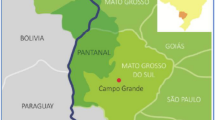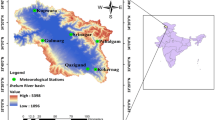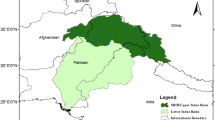Abstract
Sagar Island, setting on the continental shelf of Bay of Bengal, is one of the most vulnerable deltas to the occurrence of extreme rainfall-driven climatic hazards. Information on probability of occurrence of maximum daily rainfall will be useful in devising risk management for sustaining rainfed agrarian economy vis-a-vis food and livelihood security. Using six probability distribution models and long-term (1982–2010) daily rainfall data, we studied the probability of occurrence of annual, seasonal and monthly maximum daily rainfall (MDR) in the island. To select the best fit distribution models for annual, seasonal and monthly time series based on maximum rank with minimum value of test statistics, three statistical goodness of fit tests, viz. Kolmogorove–Smirnov test (K-S), Anderson Darling test (A 2) and Chi-Square test (X 2) were employed. The fourth probability distribution was identified from the highest overall score obtained from the three goodness of fit tests. Results revealed that normal probability distribution was best fitted for annual, post-monsoon and summer seasons MDR, while Lognormal, Weibull and Pearson 5 were best fitted for pre-monsoon, monsoon and winter seasons, respectively. The estimated annual MDR were 50, 69, 86, 106 and 114 mm for return periods of 2, 5, 10, 20 and 25 years, respectively. The probability of getting an annual MDR of >50, >100, >150, >200 and >250 mm were estimated as 99, 85, 40, 12 and 03 % level of exceedance, respectively. The monsoon, summer and winter seasons exhibited comparatively higher probabilities (78 to 85 %) for MDR of >100 mm and moderate probabilities (37 to 46 %) for >150 mm. For different recurrence intervals, the percent probability of MDR varied widely across intra- and inter-annual periods. In the island, rainfall anomaly can pose a climatic threat to the sustainability of agricultural production and thus needs adequate adaptation and mitigation measures.







Similar content being viewed by others
References
Acreman MG (1990) A simple stochastic model of hourly rainfall for Farnborough, England. J de Sci Hydrol 35(2):119–148
Anonymous (2010-2011) Department of Agriculture. Annual action plan on agriculture, South 24 Parganas, Office of the Deputy Director of Agriculture (Administration), South 24 Parganas, Government of West Bengal
Azumi SD, Shamsudin S, Rahman AA (2010) Probability distribution of rainfall depth at hourly time-scale. Int J Env Earth Sci Eng 4(12):69–73
Bandyopadhyay S (1997) Natural environmental hazards and their management: a case study of Sagar Island, India. Singapore J Trop Geogr 18(1):20–45
Barman D, Saha AR, Kundu DK, Mohapatra BS (2012) Rainfall characteristics analysis for jute based cropping system at Barrackpore, West Bengal, India. J Agr Phys 12(1):23–28
Bhakar SR, Bansal AK, Chhajed N, Purohit RC (2006) Frequency analysis of consecutive days maximum rainfall at Banswara, Rajasthan, India. J Eng Appl Sci 1(3):64–67
Bhakar SR, Iqbal M, Devanda, Chhajed N, Bansal AK (2008) Probability analysis of rainfall at Kota. Indian J Agr Res 42:201–206
Boojh R (2008) Climate change and Sunderban Biosphere Reserve in India. In: International Conference of Island and Coastal Biosphere Reserves: Climate Change & Island and Coastal Ecosystems. Jeju Special Self-Governing Province, Republic of Korea, UNESCO, Jakarta 3–6 December: 70-74
Bulner MG (1979) Principles of statistics, 2nd edn. Dover, New York, pp 1–252
Choudhury BU, Das A, Ngachan SV, Slong A, Bordoloi LJ, Choudhwry P (2012) Trend analysis of long term weather variables in mid-Altitude Meghalaya, North-East India. J Agr Phys 12(1):1–12
Choudhury BU, Singh AK, Pradhan S (2013) Estimation of crop coefficients of dry seeded irrigated rice–wheat rotation on raised beds by field water balance method in the Indo-Gangetic plains, India. Agric Water Manag 123:20–31
Das NG (2007) Statistical methods in commerce, accountancy and economics. Part II, M Das and Co. BB- 67, Salt Lake, Kolkata-64: 92-159
Gopinath G (2010) Critical coastal issues of Sagar Island, East coast of India. Environ Monitoring Assess 160:555–561
Husak GJ, Michaelsen J, Funk C (2007) Use of the gamma distribution to represent monthly rainfall in Africa for drought monitoring applications. Int J Climatol 27:935–944
Katz RW, Parlange MB (1996) Mixtures of stochastic processes: application to statistical downscaling. Clim Res 7:185–193
Khudri MM, Sadia F (2013) Determination of the best fit probability distribution for annual extreme precipitation in Bangladesh. Eur J Sci Res 103 (3):391-404. http://www.europeanjournalofscientificresearch.com/
Li L, Zhao L, Gong Y, Tian F, Wang Z (2012) Probability distribution of summer daily precipitation in the Huaihe Basin of China based on gamma distribution. Acta Meteorl Sin 26(1):72–84
Majumdar RK, Das D (2011) Hydrological characterization and estimation of aquifer properties from electrical sounding data in Sagar Island Region, South 24 Parganas, West Bengal, India. Asian J Earth Sci 4(2):60–74
Mall RK, Gupta A, Singh R, Singh RS, Rathore LS (2006) Water resources and climate change: an Indian perspective. Curr Sci 90(12):1610–1626
Mandal S, Choudhury BU, Mondal M, Bej S (2013) Trend analysis of weather variables in Sagar Island, West Bengal, India: a long-term perspective (1982–2010). Curr Sci 105(7):947–953
Manikandan M, Thiyagarajan G, Vijayakumar G (2011) Probability analysis for estimating annual one day maximum rainfall in Tamil Nadu Agricultural University. Madras Agri J 98(1–3):69–73
Maurya VN, Arora DK, Maurya AK, Gautam RS (2013) Exact modelling and analytical study of annual maximum rainfall with Gumbel and Frechet distributions using parameter estimation techniques. Wor Sci J 2:11–22
Mazandarani GA, Ahmadi AZ, Ramazani Z (2013) Investigation analysis of the agronomical characteristics of the daily rainfall in rain-fed agriculture (case study: Tehran). Int J Agric Crop Sci 5(6): 612-619. http://www.ijagcs.com/
Mehta DR, Kalola AD, Saradava DA, Yusufazi AS (2002) Rainfall variability analysis and its impact on crop productivity—a case study. Indian J Agric Res 36(1):29–33
Nemichandrappa M, Balakrishnan P, Senthilvel S (2010) Probability and confidence limit analysis of rainfall in Raichur Region, Karnataka. J Agr Sci 23(5):737–741
Oldeman LR, Frere M (1982) A study of the agroclimatology of the humid tropics of Southeast Asia. Secretariat of the World Meteorological Organization, Rome, p 229
Olofintoye OO, Sule BF, Salami AW (2009) Best-fit Probability distribution model for peak daily rainfall of selected cities in Nigeria. New York Sci J 2(3):1-11. http://www.sciencepub.net/newyork
Olumide BA, Olekma GA, Olayinka JI (2013) Effect of vegetation density on the hydrodynamic of submerged vegetated flow. Int J Eng Res Tech 2(4):994–1005
Panigrahi B, Panda SN (2001) Analysis of weekly rainfall for crop planning in rainfed region. J Agric Eng 38(4):47–57
Roman UC, Porey PD, Patel PL, Vivekanandan N (2012) Assessing adequacy of probability distributional model for estimation of design storm. ISCA J Eng Sci 1(1):19–25
Salarpour M, Yusop Z, Yusof F (2012) Modeling the distributions of flood characteristics for a tropical river basin. J Env Sci Tech 5(6):419–429. doi:10.3923/jest.2012.419.429
Salaudeen FA, Yusuf KO (2008) Comparison of probability distribution models for the prediction of annual flow regime along Niger and Benue in Nigeria. USEP: J Res Inf Civil Eng 5(1):68–81
Sharma MA, Singh JB (2010) Use of probability distribution in rainfall analysis. New York Sci J 3: 40-49. http://www.sciencepub.net/newyork
Singh VP, Singh RK (2000) Rainfed rice: a source book of best practices and strategies in Eastern India: 292. IRRI, Manila
Singh AK, Zehe E, Bardossy A (2005) Downscaling atmospheric circulation data for monsoon rainfall forecasting in India. Regional hydrological impacts of climate change-Hydroclimatic Variability (Proceedings of symposium 56 held during the seventh IAHS scientific assembly at Foz do Iguacu, Brazil, April 2005). IAHS Publ 296:p291
Singh B, Rajpurohit D, Vasishth A, Singh J (2012) Probability analysis for estimation of annual one day maximum rainfall of Jhalarapatan area of Rajasthan. Plant Arch 12:1093–1100
Suhaila J, Jemain AA (2007) Fitting daily rainfall amount in Peninsular Malaysia using several types of exponential distributions. J Appl Sci Res 3(10):1027–1036
Sulochanan B, Koteeswaran M (2000) prediction of maximum daily rainfall at Ootacamund. Mndras Agric J 87(10–12):597–600
Zaw WT, Naing TT (2008) Empirical statistical modeling of rainfall prediction over Myanmar. Wor Acad Sci Eng Tech 2:10–27
Author information
Authors and Affiliations
Corresponding author
Rights and permissions
About this article
Cite this article
Mandal, S., Choudhury, B.U. Estimation and prediction of maximum daily rainfall at Sagar Island using best fit probability models. Theor Appl Climatol 121, 87–97 (2015). https://doi.org/10.1007/s00704-014-1212-1
Received:
Accepted:
Published:
Issue Date:
DOI: https://doi.org/10.1007/s00704-014-1212-1




